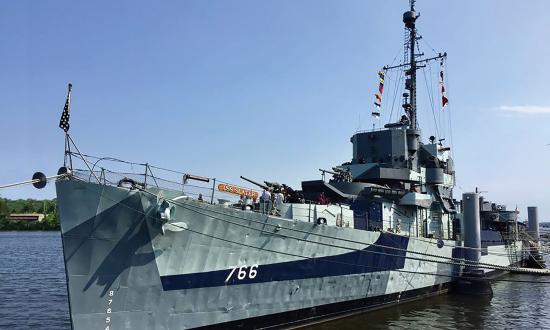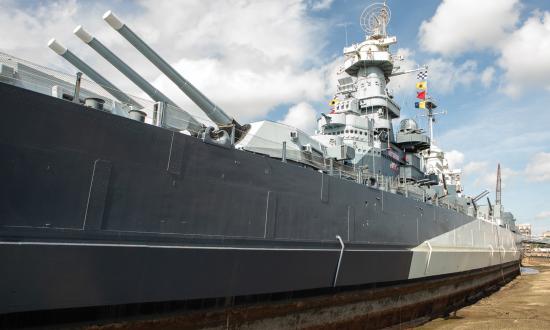Happy 50th to the Navy’s Oldest Deployable Warship
The amphibious command ship USS Blue Ridge (LCC-19), the oldest operational ship in the U.S. Navy, commemorated her 50th anniversary on 14 November.
Commissioned at the Philadelphia Naval Shipyard in 1970, the Blue Ridge has served as a unique platform for global command-and-control coordination. The first ship in her class, at the time of her commissioning the Blue Ridge represented a breakthrough accomplishment in Navy ship design and was considered one of the most technologically advanced ships ever built.
In December 1979, the Blue Ridge forward-deployed to Yokosuka, Japan, and became the new flagship of U.S. Seventh Fleet.
“There is no better ship to support us as our flagship,” said Vice Admiral Bill Merz, Commander, U.S. Seventh Fleet, in his 50th-anniversary remarks. “Year after year she has enabled operations of the largest forward fleet, while at the same time participating in joint service and multinational exercises, and supporting disaster relief operations. Everyone knows Blue Ridge—she has a rich history here in the region.”
“As the oldest ship in the fleet, she still runs like new, which wouldn’t be possible without the support of our local Yokosuka community,” said Captain Craig Sicola, commanding officer of the Blue Ridge. “For over four decades, the local maintenance facilities and community members have been dedicated to helping us keep Blue Ridge in operation and ready to serve in the region.”
From 21 July 1979 to 30 June 1984, the Blue Ridge and other ships in the western Pacific participated in Operation Boat People, a mission conducted to rescue Vietnamese refugees off the coast of Vietnam.
While transiting the South China Sea on 6 October 1980, the Blue Ridge rescued 91 refugees from two separate small boats, earning her the Humanitarian Service Medal.
In the 2000s and 2010s, the Blue Ridge participated in numerous annual U.S. and allied training exercises, routine patrols, and special operations—most notably, Operation Tomodachi, the disaster-relief effort mounted in the wake of the 2011 Japanese earthquake and tsunami.
Though she is now 50 years old, the Blue Ridge still has plenty of life in her: She is expected to be in service until 2039.
Blue Angels Conduct Final ‘Legacy’ Hornet Flight
The Blue Angels, the U.S. Navy’s renowned flight demonstration squadron, conducted a final flight of the F/A-18 A/B/C/D “Legacy” Hornets on 4 November. Taking off and landing from Naval Air Station Pensacola, Florida, the Angels made flyovers at various area locales on this last hurrah of the Legacy Hornets.
Their final flight signified the official transition of the Blue Angels to the F/A-18E/F Super Hornet platform.
“We are incredibly honored to have the opportunity to salute those teams who have flown, maintained and supported this platform for over three decades of service,” said Commander Brian Kesselring, Blue Angels commanding officer and flight leader. “We deeply appreciate the expertise and operational knowledge Blue Angels past and present have brought to the team, and we look forward to enhancing our operations as we fully transition to flying the Super Hornet.”
The 2020 show season marked the end of the service life of the aircraft the team had flown for 34 years. The 2021 show season will be the Blue Angels’ first year flying the Super Hornet platform, as well as being the 75th anniversary of the team.
“Undoubtedly, 2020 presented the team with unprecedented challenges,” said Kesselring. “That said, the unique nature of this year also allowed our team to deepen our interaction with past teams, in particular, those teams that transitioned to new aircraft during their tenure.”
He added, “This engagement has helped us lay the foundation for a safe and effective transition for our team’s pilots, support, and maintenance personnel as well as postured us to take on the high operating tempo of the team’s highly anticipated 2021 air show season and 75th anniversary.”
Does Nazi Shipwreck Hold Clue to Lost Treasure of World War II?
Polish divers with the underwater-archaeology outfit Baltictech, who discovered a shipwreck in the Baltic Sea north of Ustka, announced this fall that they have positively identified it as that of the German steamship Karlsruhe—used to evacuate Nazi troops and matériel in the face of advancing Soviet forces in the waning days of World War II.
Crammed with evacuees and hundreds of tons of cargo on her final, fatal voyage, the Karlsruhe may hold the clue to one of the enduring unsolved mysteries of the war: What happened to the Amber Room?
The Nazis, notorious for plundering the great art treasures of Europe wherever they conquered, reached their apex of large-scale art theft when they packed up and hauled off a marvel variously referred to as “the Eighth Wonder of the World” and “one of mankind’s greatest treasures”: the legendary Amber Room, commissioned by Frederick I of Prussia in 1701 and presented as a gift to Tsar Peter the Great.
Located in the Catherine Palace near St. Petersburg, the blindingly opulent Amber Room “stood as a symbol of Russian glory for 200 years—until the Nazis invaded,” according to The Amber Room: The Fate of the World’s Greatest Lost Treasure, by Catherine Scott-Clark and Adrian Levy.
“The vast, intricately worked panels of the Amber Room—many times more valuable than gold—were wrenched from their walls, packed into crates, and taken to Königsberg on the Baltic coast, where they remained until the German surrender in 1945.
“The Amber Room has never been seen since.”
The discovery of the wreck of the Karlsruhe may provide groundbreaking information on the disappearance of the Amber Room, say the Baltictech divers, because it was in Königsberg where the room’s stolen treasures were seen for the last time—and it was from Königsberg that the Karlsruhe made her final foray. The last ship to leave the port before the Russian occupation of East Prussia, she set off on her final voyage under extremely tight security—and with quite a heavy load for a ship of her size.
The Karlsruhe was taking part in Operation Hannibal, one of the largest maritime evacuations in history. Thanks to this operation, at the end of the war the Germans transferred some 2 million refugees from East Prussia to the west.
The Karlsruhe left Königsberg on 11 April 1945. On board were 150 soldiers of the “Herman Göring” Division (the 1st Paratroop Panzer Division), 25 railway workers, and 888 refugees. Along with the crew, there was a total of 1,083 people.
The ship also carried 360 tons of crated cargo and various military vehicles. A convoy consisting of four freighters and three minesweepers was formed near the Hel Peninsula. Leaving the roadstead of Hel on 12 April, the convoy was detected by Soviet aircraft on the morning of 13 April; in the ensuing attack, the Soviets sank the Karlsruhe. She went down within three minutes with her entire cargo. Only 100 people were saved. The position of the attack was imprecise, and the location of the wreck’s resting place was unknown—until recently.
The wreck is “virtually intact,” according to Baltictech. In her cargo holds, divers so far have discovered military vehicles, porcelain, and “many chests with so far unknown contents.”
What lies beneath the waves in those chests? Now coordinating its efforts with Poland’s National Maritime Museum, Baltictech hopes to find that out in its next expedition.










